
The Kriegsmarine was the navy of Germany from 1935 to 1945. It superseded the Imperial German Navy of the German Empire (1871–1918) and the inter-war Reichsmarine (1919–1935) of the Weimar Republic. The Kriegsmarine was one of three official branches, along with the Heer and the Luftwaffe, of the Wehrmacht, the German armed forces from 1935 to 1945.

An ensign is the national flag flown on a vessel to indicate nationality. The ensign is the largest flag, generally flown at the stern (rear) of the ship while in port. The naval ensign, used on warships, may be different from the civil ensign or the yacht ensign. Large versions of naval ensigns called battle ensigns are used when a warship goes into battle. The ensign differs from the jack, which is flown from a jackstaff at the bow of a vessel.

A brig is a type of sailing vessel defined by its rig: two masts which are both square-rigged. Brigs originated in the second half of the 18th century and were a common type of smaller merchant vessel or warship from then until the latter part of the 19th century. In commercial use, they were gradually replaced by fore-and-aft rigged vessels such as schooners, as owners sought to reduce crew costs by having rigs that could be handled by fewer men. In Royal Navy use, brigs were retained for training use when the battle fleets consisted almost entirely of iron-hulled steamships.

The Battle of the River Plate is a 1956 British war film in Technicolor and VistaVision by the writer-director-producer team of Michael Powell and Emeric Pressburger. The film stars John Gregson, Anthony Quayle, Bernard Lee and Peter Finch. It was distributed worldwide by Rank Film Distributors Ltd.
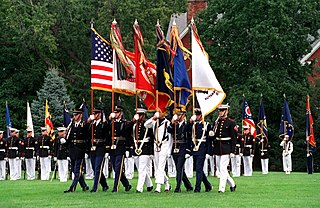
The several branches of the United States Armed Forces are represented by flags. Within the U.S. military, various flags fly on various occasions, and on various ships, bases, camps, and military academies.

HMS Glorious was the second of the three Courageous-class battlecruisers built for the Royal Navy during the First World War. Designed to support the Baltic Project championed by the First Sea Lord, Lord Fisher, they were relatively lightly armed and armoured. Glorious was completed in late 1916 and spent the war patrolling the North Sea. She participated in the Second Battle of Heligoland Bight in November 1917 and was present when the German High Seas Fleet surrendered a year later.
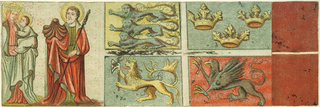
A maritime flag is a flag designated for use on ships, boats, and other watercraft. Naval flags are considered important at sea and the rules and regulations for the flying of flags are strictly enforced. The flag flown is related to the country of registration: so much so that the word "flag" is often used symbolically as a metonym for "country of registration".
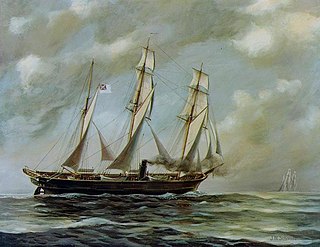
CSS Alabama was a screw sloop-of-war built in 1862 for the Confederate States Navy at Birkenhead on the River Mersey opposite Liverpool, England by John Laird Sons and Company. Alabama served as a successful commerce raider, attacking Union merchant and naval ships over the course of her two-year career, during which she never docked at a Southern port. She was sunk in June 1864 by USS Kearsarge at the Battle of Cherbourg outside the port of Cherbourg, France.

The White Ensign, at one time called the St George's Ensign due to the simultaneous existence of a cross-less version of the flag, is an ensign worn on British Royal Navy ships and shore establishments. It consists of a red St George's Cross on a white field, identical to the flag of England except with the Union Flag in the upper canton.

The commissioning pennant is a pennant flown from the masthead of a warship. The history of flying a commissioning pennant dates back to the days of chivalry with their trail pendants being flown from the mastheads of ships they commanded. Today, the commissioning pennants are hoisted on the day of commissioning and not struck until they are decommissioned. Some navies have a custom of flying a "paying off" or "decommissioning pennant," the length of which often reflects the length of service of the warship.

Striking the colors—meaning lowering the flag that signifies a ship's or garrison's allegiance—is a universally recognized indication of surrender, particularly for ships at sea. For a ship, surrender is dated from the time the ensign is struck.

The Battle of the North Cape was a Second World War naval battle that occurred on 26 December 1943, as part of the Arctic campaign. The German battleship Scharnhorst, on an operation to attack Arctic convoys of war materiel from the western Allies to the Soviet Union, was brought to battle and sunk by the Royal Navy's battleship HMS Duke of York with cruisers and destroyers, including an onslaught from the destroyer HNoMS Stord of the exiled Royal Norwegian Navy, off the North Cape, Norway.

The First Navy Jack was the naval jack of the United States from 1975 to 1976 and again from 2002 to 2019. It was authorized by the U.S. Navy and was flown from the jackstaff of commissioned vessels of the U.S. Navy while moored pierside or at anchor. Since then, it is used only as a naval jack by the oldest active warship in the U.S. Navy. The design is traditionally regarded as that of the first U.S. naval jack, flown soon after independence, but this is not supported by the historical record.

Operation Zitronella, also known as Unternehmen Sizilien, was an eight-hour German raid on Spitzbergen, in the Svalbard Archipelago, on 8 September 1943. The battleships Tirpitz and Scharnhorst, plus nine destroyers, sailed to the archipelago, bombarded Allied-occupied settlements in Isfjorden and covered a landing party. Six Norwegians were killed and 31 were taken prisoner; sixteen Germans were wounded, one dying of his wounds.
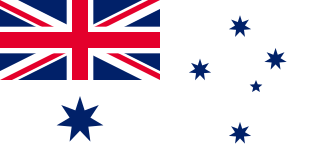
The Australian White Ensign is a naval ensign used by ships of the Royal Australian Navy (RAN) from 1967 onwards. From the formation of the RAN until 1967, Australian warships used the British White Ensign as their ensign. However, this led to situations where Australian vessels were mistaken for British ships, and when Australia became involved in the Vietnam War, the RAN was effectively fighting under the flag of another, uninvolved nation. Proposals were made in 1965 for a unique Australian ensign, which was approved in 1966, and entered use in 1967.

The jack of the United States, referred to as the Union Jack by the U.S. Navy, is a maritime jack flag flown on the bow of U.S. vessels that are moored or anchored. In addition to commissioned U.S. Navy ships, the jack is used by the U.S. Coast Guard, the Military Sealift Command, the ships of the National Oceanic and Atmospheric Administration, and other U.S. government entities. While anchored or moored, the jack is flown on the bow of a ship, and the ensign is flown on the stern. Once under way, the jack is lowered.
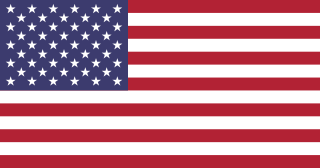
The ensign of the United States is the flag of the United States when worn as an ensign. International maritime law—see International Treaty on Law of the Sea, articles 91 and 92—provides that vessels have a "national character" and thus should display a flag (ensign) that corresponds to this national character, especially when in international or foreign waters. Vessels that are formally documented under the federal vessel documentation act, vessels owned by government bodies in the United States, and vessels in the U.S. military unquestionably have U.S. national character, and thus properly hoist a U.S. ensign to show their national character. Vessels that are numbered by the states and small, non-registered craft owned by U.S. citizens and not registered in other countries may also hoist a U.S. ensign to show their national character.
Skule Valentin Storheill was a Norwegian naval officer who reached prominence in World War II while serving aboard Norwegian warships within the Royal Navy, and received Norway's highest military decoration, the War Cross with Sword.

Håkon Nilsen, Stavanger, Norway, popularly known as "Torpedo Nilsen", was a Norwegian war veteran and highly decorated allied naval torpedo commander of World War II.






















